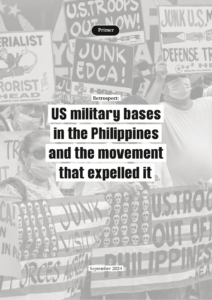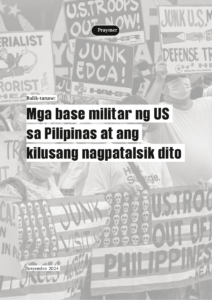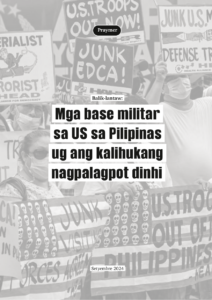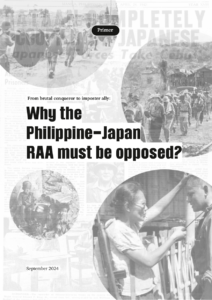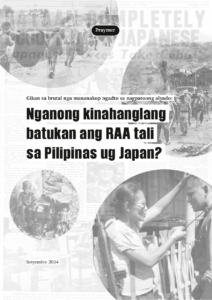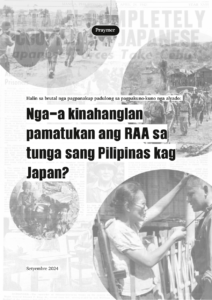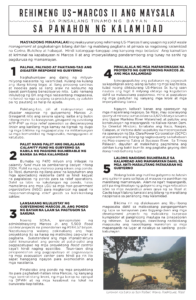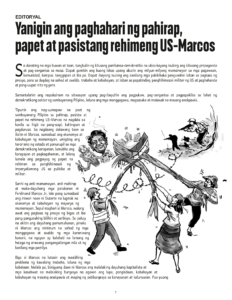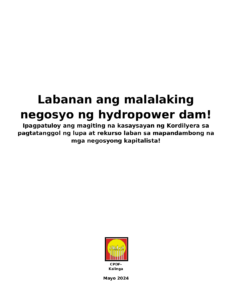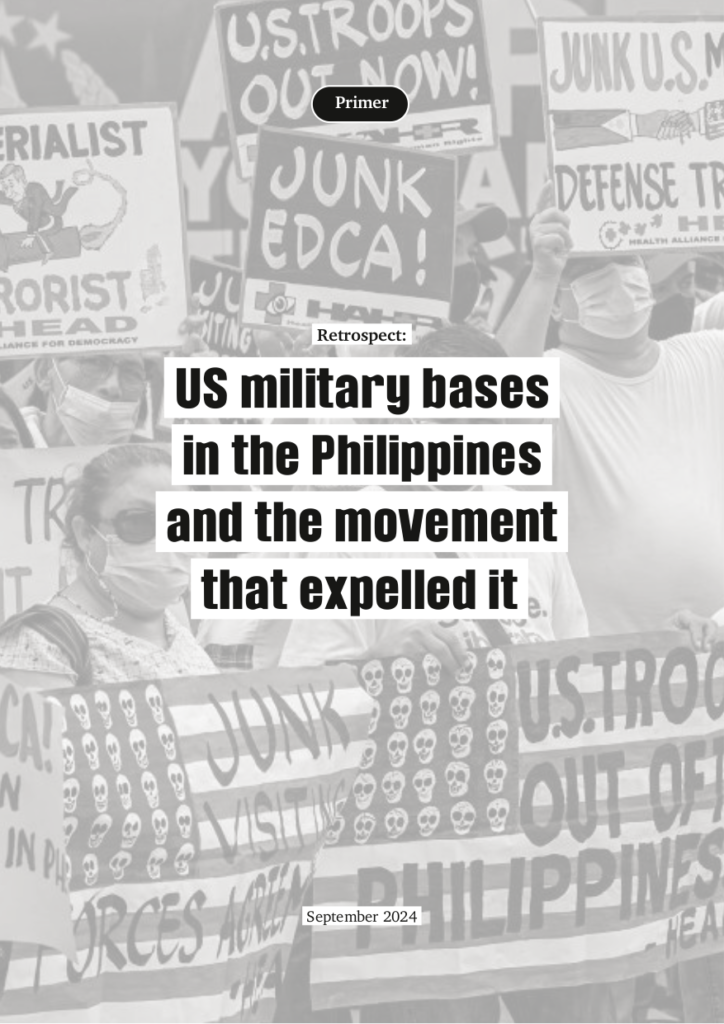
(Primer) Retrospect: US military bases in the Philippines and the movement that expelled it
Download: PDF PDF (Black & White)
After US imperialism imposed its semi-colonial rule in the Philippines, several decades before the Communist Party of the Philippines was reestablished, the Filipino people had already stood up against US military bases and military intervention in the country. As a continuation of the militant anti-colonial workers’ movement of the early 20th century, some patriotic forces, including some legislators, continued to oppose the presence of American troops in the Philippines. Their stand later shaped a mass movement in the early 1960s with the reinvigorated national-democratic movement at the forefront. It was undeterred by the imposition of martial law of the Marcos dictatorship in 1972-1986. It continued to advance during the US-Aquino I regime and became a powerful movement in 1990-1991. The five decades of struggle culminated in the rejection of the Military Bases Agreement (MBA) on September 16, 1991.
It is crucial and urgent that we look back at the history of the US military bases amid the construction of new US military bases in the Philippines under the Enhanced Defense Cooperation Agreement (EDCA) and the stationing of American soldiers in Philippines. As before, the country is now facing the issue of violation of sovereignty, social injustice, plunder and damage to resources and abuse by American troops.
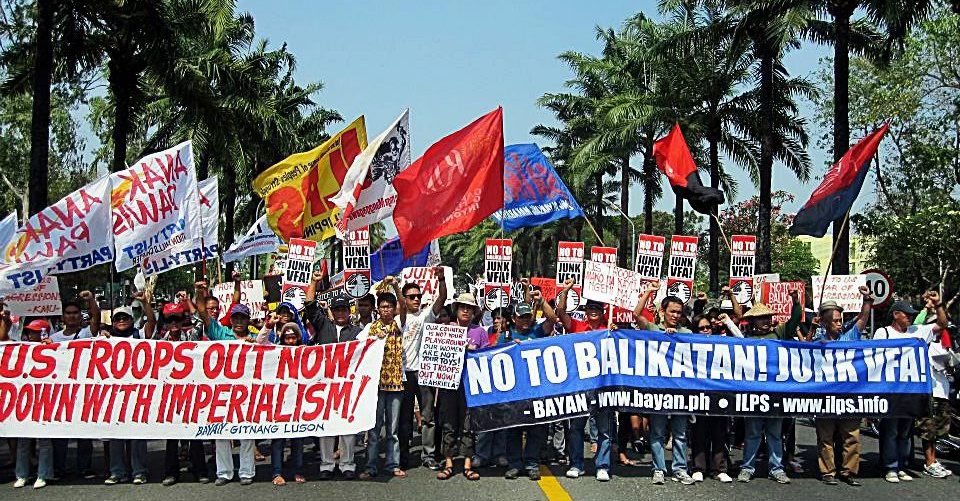
1) What is the Military Bases Agreement?
The MBA is a military agreement between the Philippines and the US signed on March 14, 1947 that allowed for the construction of US military bases in the Philippines with a lease of 99 years. This was renegotiated in 1966 that shortened this period to 25 years.
The US first conceived the plan to establish military bases in the Philippines in 1944 for the supposed “defense” of the Philippines which was then under the brutal occupation of Japan. The MBA is among the anti-national policies and lopsided agreements between the US and the Philippines following the US “grant” of Philippines “independence” in 1946.
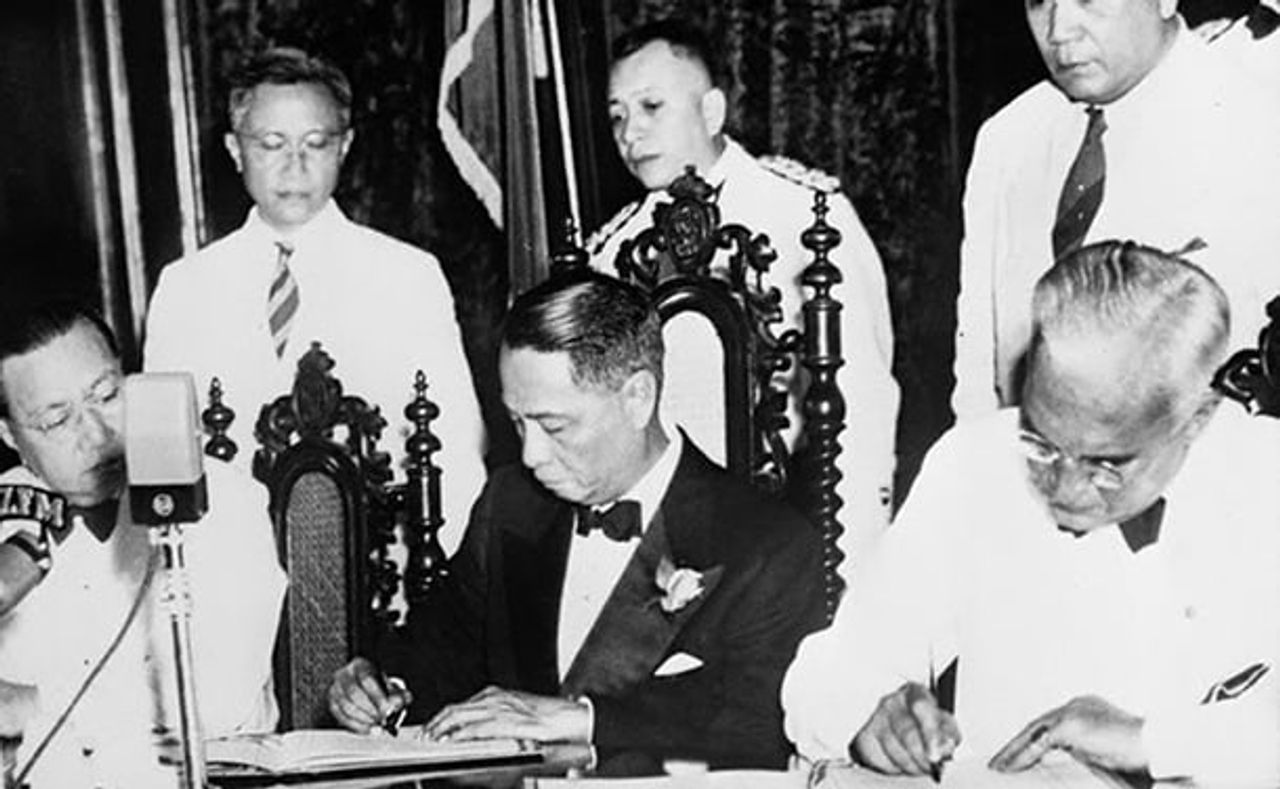
Under the MBA, the US established at least 23 major military bases in its former military camps. Foremost among these are its camp in Pampanga (Clark Field Airbase or the former Fort Stotsenberg, and the Floridablanca Air Base), Zambales (Subic Bay, Northwest Shore Naval Base, Naule Point and Castillejos), Baguio (Camp John Hay Leave and Recreation Center), Manila (Manila Naval Base) and Cavite (Canacao-Sangley Point Navy Base). In addition, the US also built communication, training and defense bases and facilities in Bataan, Bulacan, Leyte, Samar, Tawi Tawi, Palawan, Cebu, La Union and Aparri in Cagayan. Communication facilities were also built in Bagobantay in Quezon City.
The US seized at least 108,500 hectares of land for these military bases. One of the largest bases, Clark Airbase (36,000 hectares), was built on the ancestral land of the Aetas. No compensation was given to the indigenous peoples nor were they returned to these lands.
2) What has been the effect of military bases on Philippine sovereignty?
The US military bases occupying wide swathes of Philippine land was a stark manifestation that Philippine independence is a farce. The presence of US military bases and troops was a blatant violation of the country’s sovereignty. The US used the presence of tens of thousands of its armed troops in the Philippines to ensure that the puppet state and armed forces of the Philippines are under its control and command.
Under the MBA, the US enjoyed extraterritorial and extrajudicial rights both inside and outside its military bases. Filipinos have no power or jurisdiction over American activities and forces. They are immune from prosecution, arrest, trial and imprisonment under Philippine laws. Troops who have committed crimes against Filipinos are simply sent home to the US or reassigned. Not one was ever punished nor indicted by the US.
3) What were its effects on the Filipinos’ livelihood and community?
American troops committed thousands of cases of abuse and crimes against Filipinos in its military bases in the country. This includes 30 cases of murder, as well as cases of shooting and beating, abduction and rape. Under the MBA, none of the American soldiers involved were punished in these cases.
Military bases in Clark and Subic became centers of prostitution where violence against women became widespread. Up to 60,000 women fell into prostitution (including 20,000 minors). Up to 3,274 cases of violence against women, including rape, involving American soldiers were recorded. Fifteen of the abuses were against minors.
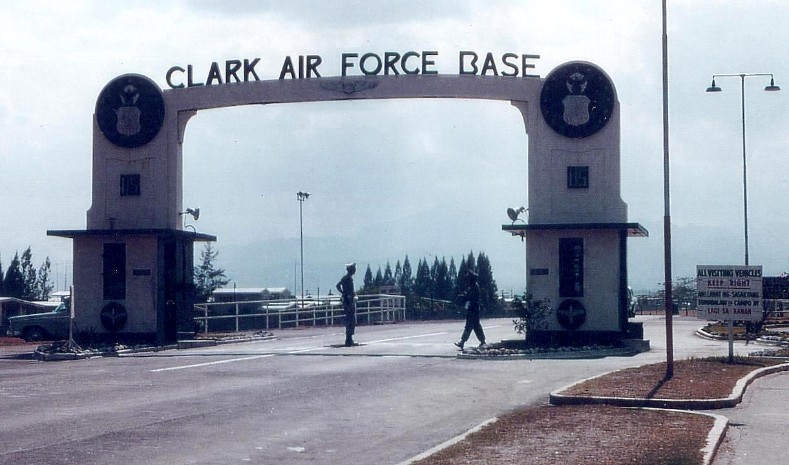
AIDS spread in these areas and infected minors and newborn babies (passed from their mothers).
The Americans committed environmental destruction and disrupted the lives of civilians in and out of the bases. Its forces dumped toxic chemicals that have harmed the health of residents. In 1991, an estimated 20,000 families suffered from diseases after they lived in houses abandoned by American soldiers. In 2000, up to 100 people reportedly died from drinking contaminated water from Clark Airbase.
The Americans abruptly left after the Pinatubo volcano erupted burying Clark Airbase in ash. Instead of paying the agreed upon corresponding damages, the US only provided $17 million or 1% of the funds for its “domestic base cleanup” or cleaning of military bases within the US. It also refused to give up some facilities that would have benefited the Philippines, such as the drydocks in Subic.
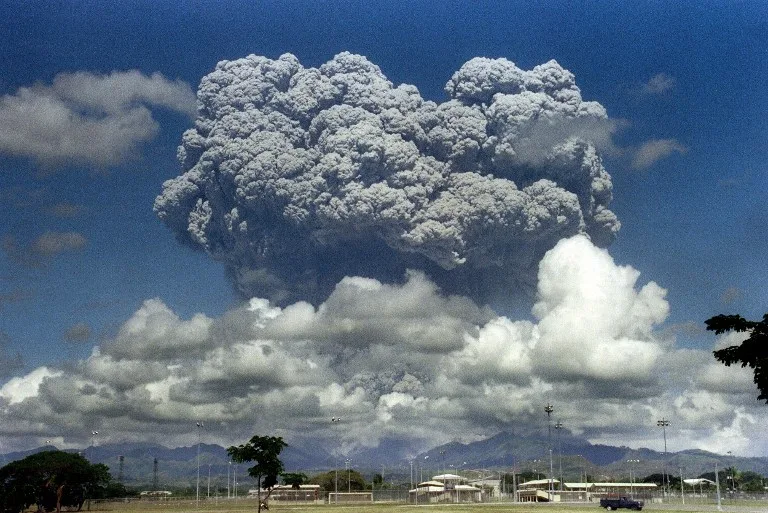
4) How did the US use its military bases in the Philippines?
The MBA ensured the US’ continued domination of the Philippines as a semi-colony. The Military Assistance Agreement was concurrently signed in 1947, an agreement that established the Joint United States Military Advisory Group (JUSMAG). In this framework, the US has tightened command and control over the Armed Forces of the Philippines (AFP), the pillar of its neocolonial state in the Philippines. The US provided “military aid” for “development and training,” as well as arms and other military equipment to the AFP, in addition to the indoctrination of its officers and personnel. The US used the military bases for AFP training. This ensured that the AFP would long remain dependent and loyal to the US.
The construction of US military bases in the Philippines was part of the US broader strategy of imposing its hegemony in Asia after World War II. At the same time, extensive bases were also built in Japan and Korea.
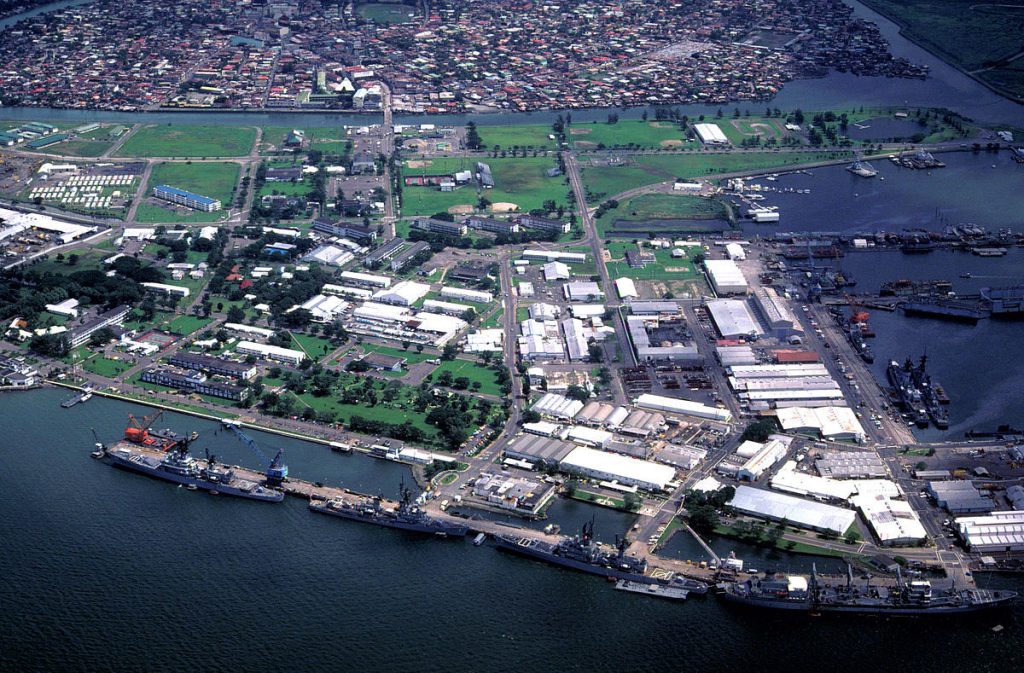
The US used its bases in the Philippines, especially Subic and Clark, for its wars of aggression and intervention from Asia, the Middle East, to South America. It stationed the US Navy’s 7th Fleet in Subic Bay from 1969, which performed a key part in its atrocities against the Vietnamese people from 1961 to 1975. Its ships from Subic transported occupation troops, which at the height of the war reached 540,000. Clark Air Base served as the headquarters of the US 13th Air Force, and a supply base and operations center for US warplanes. The Philippines also sent support troops to the US war of aggression in Vietnam which resulted in the heinous killing of over 2 million civilians.
In addition to the US war in Vietnam, the 7th Fleet was also involved in US invasions and aggressions in the Korean Peninsula (1950-1953), conflicts in the Taiwan Strait (1954-1955, 1958), Lebanon (1958), Dominican Republic (1965 ) and Laos (1962-1975). It also served to launch US troops sent to the Iran conflict (1979-1980) and the first Gulf War (1990-1991).
5) How were the US military bases in the Philippines expelled?
From the outset, the Filipino people stood against the presence of US military bases in the Philippines. Their patriotic aspirations were given voice by prominent personalities such as senators Claro M. Recto, Jose W. Diokno and Lorenzo Tañada. They considered the military bases as a symbol of the absence of genuine Philippine independence and continued indirect US colonial domination of the country.
The resistance to the bases became the center of the renewed anti-imperialist movement of the Filipino people, with the emergence of the national-democratic youth movement led by Kabataang Makabayan in the 1960s. It was also at the center of the program of the re-establishment of the Communist Party of the Philippines in 1968 and the formation of the New People’s Army (NPA) the following year. One of the first tactical offensives by the NPA was an ambush against American troops at Clark Air Base on July 31, 1969 and again on August 4, 1969. It blew up a part of the military base causing 14 casualties among American soldiers.
One of the central issues of the First Quarter Storm was US domination in the Philippines, mainly in the form of its bases and control over the FP. When martial law was imposed, the struggle against US presence was continued by the emerging national-democratic organizations of youth, women, labor and other sectors that took to the streets in the 1970s and 1980s. These highlighted the role of women and church people, in exposing and fighting rampant prostitution, violence against women and injustice around the bases in Clark and Subic.
The issue of military bases is closely linked to the fascist dictatorship of Ferdinand Marcos Sr, who was then a clear puppet of US imperialism and the main defender of its presence in the country. Amid strong nationalist protests, Marcos in 1979 renegotiated the MBA, in which it was agreed upon that a Filipino “commander” will be assigned the US military bases (nevertheless having no control over the operations inside), and that the US would pay an annual lease of $500 million over five years, which would be increased to $900 million in subsequent five years.
The movement against military bases and US intervention continued and intensified even after the Marcos dictatorship’s fall.
Proof of the strength attained by the anti-US military bases movement is the inclusion of provisions in the reactionary 1987 Constitution which banned the entry of nuclear weapons into the Philippines and prohibited the construction of foreign military bases (although a rider was inserted, allowing it with a treaty).
Various groups came together under the Anti-Bases Coalition in 1986 to campaign for the repeal of the MBA which was set to expire in 1991. Its leaders included Jose Diokno and Lorenzo Tañada, and groups such as Bagong Alyansang Makabayan, Nuclear-Free Philippines Coalition, Gabriela, League of Filipino Students, National Union of Students of the Philippines, and many other patriotic and progressive organizations. Its formations were established in different parts of the country. It led a widespread propaganda and education movement in schools, churches, and communities.
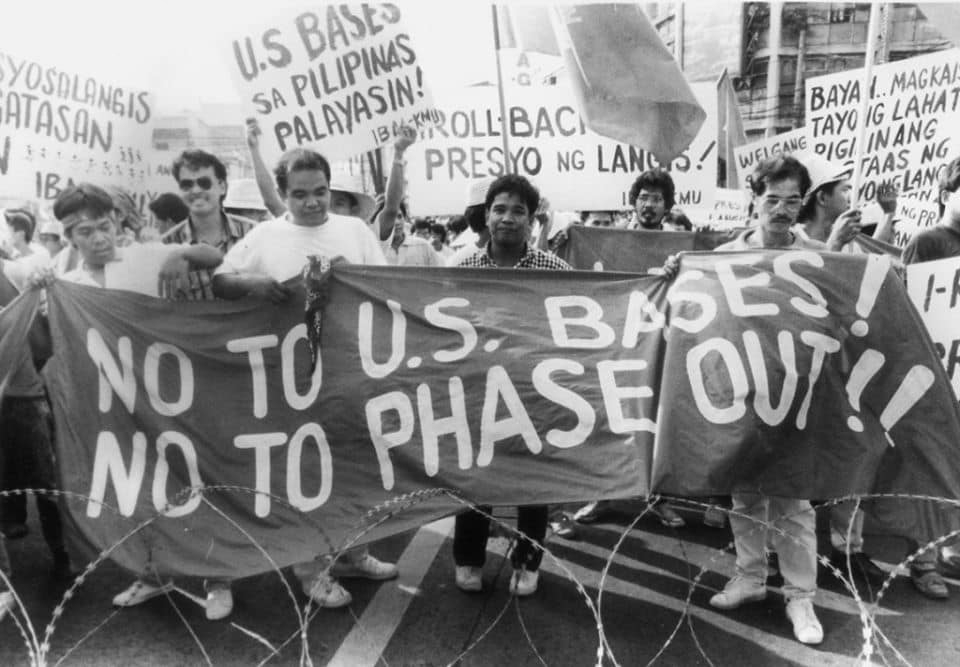
As the end of the Military Bases Agreement in 1991 approached, street rallies and marches expanded further and further. Historians said up to 50,000 people rallied in front of the Senate on September 10, 1991. By September 16, 1991, about 170,000 people rallied in front of the Senate to call for the scrapping of the treaty. Similar actions were also held in different parts of the country. On that day, the Senate voted 12-11 to reject the proposal of Corazon Aquino’s puppet regime, the Treaty of Friendship, Cooperation and Security, which would extend the stay of US military bases in the Philippines for another 10 years. This historic vote was led by senators Wigberto Tañada, Rene Saguisag, Teofisto Guingona Jr. and Aquilino Pimentel Jr.
________
THE FILIPINO PEOPLE achieved great success in scrapping the MBA and shutting down the US military bases in the Philippines. However, other unequal military agreements remained, primarily the Mutual Defense Treaty (MDT) of 1951, which the US and successive puppet regimes used to perpetuate its military presence in the country.
In 1998, the Visiting Force Agreement was forged to allow the entry and exit of American troops into the country. When the treaty was effected the following year, the US began deploying large numbers of troops under the guise of joint exercises, humanitarian aid and civil-military operations.
In 2002, American troops began to permanently station in the Philippines. The Mutual Logistics Support Agreement was signed that year to allow for “joint exercises” and other activities to conceal US invasive operations in the Philippines. By 2003, the then Arroyo regime signed the Acquisition and Cross-Servicing Agreement.
Under the guise of the “war against terrorism,” the US assigned to the Philippines the Joint Special Operations Task Force—Philippines. Under the VFA, hundreds of American troops were stationed inside Camp Navarro in Zamboanga City. The US used this as a base for intervention in counter-guerrilla operations in Western Mindanao, as well as in other parts of the country. The US was involved in armed operations in Mamasapano in 2015 and in Marawi in 2017.
To further expand the presence of American troops in the Philippines, the Enhanced Defense Cooperation Agreement was signed in April 2014 which allowed the US to rebuild military bases in the Philippines, within the so-called “agreed locations”, inside AFP military camps. This is within the framework of the so-called “pivot to Asia” declared by the US in 2011 with the strategic goal of strengthening US hegemony in the region.
During his time, Duterte engaged in anti-US rhetoric to attract China’s support, but it proved empty (Duterte himself said it was just a tactic “to get more money” in the form of greater military aid from the US). The US ended JSOTF-P in 2016, but in 2017, it started Operation Pacific Eagle-Philippines, which focused on Western Mindanao, and covered different parts of the country.
Since Marcos took office, US military bases have increased from five to 17, including nine officially agreed upon under the EDCA, and at least eight more in undisclosed or secret locations. US military bases are now being used to house American weapons and troops, in conjunction with its increased armed presence in Japan and South Korea in line with its Indo-Pacific Strategy to encircle and contain the rise of China.
_____
Prepared by:
Information Bureau
Communist Party of the Philippines
September 2024

